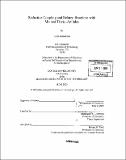| dc.contributor.advisor | Christopher C. Cummins. | en_US |
| dc.contributor.author | Mendiratta, Arjun | en_US |
| dc.contributor.other | Massachusetts Institute of Technology. Dept. of Chemistry. | en_US |
| dc.date.accessioned | 2006-03-29T18:48:39Z | |
| dc.date.available | 2006-03-29T18:48:39Z | |
| dc.date.copyright | 2005 | en_US |
| dc.date.issued | 2005 | en_US |
| dc.identifier.uri | http://hdl.handle.net/1721.1/32483 | |
| dc.description | Thesis (Ph. D.)--Massachusetts Institute of Technology, Dept. of Chemistry, 2005. | en_US |
| dc.description | Vita. | en_US |
| dc.description | Includes bibliographical references. | en_US |
| dc.description.abstract | Chapter 1: The capability of Mo(N[t-BulAr)₃ to act as a powerful one, two, and three electron reductant have been previously demonstrated. In this work, we show that Mo(NIt-BulAr)₃ forms a metastable adduct with the moderate [pi] acid PhCN; coordination of PhCN activates the nitrile carbon towards reaction with a variety of one-electron reagents such as dichalcogenides, nitric oxide, hydrogen atom donors, cobaltocene, and elemental phosphorus. Evidence is presented for the existence of an inner-sphere electron transfer mechanism for these reactions. Chapter 2: With the facile cleavage of N₂ by Mo(Njt-Bu]Ar)₃ already established, a Mo(NIt-Bu]Ar)₃-mediated process for the incorporation of N₂ into organic molecules is an exciting prospect; its realization depends critically on the development of methods for cleavage of the Mo-N bond formed in the early stages of the process. In this chapter, we demonstrate that appropriately-substituted Mo(IV) ketiminates (synthesized using the methods of Chapter 1) undergo [beta]-elimination to cleave the Mo-N bond and liberate PhCN. We present the kinetics of the reaction, substituent effects, and-in three cases - activation parameters. Chapter 3: Deprotonation of the titanium formate complex (ArIt-BuJN)₃TiOC(O)H with LiN(i-Pr)₂ resulted in the release of free CO and the formation of a titanium(IV) oxoanion complex, isolated as its lithium salt. Chapter 4: Previous work from these labs has shown that the unique combination of well-defined composition, steric bulk, and strong reducing ability embodied in Ti(N[t- Bu]Ar)₃ lends itself particularly well to mechanistic studies of the classical Pinacol coupling. | en_US |
| dc.description.abstract | (cont.) As shown in Chapter 1, a similar relationship can be drawn between Mo(NIt- BulAr)₃ and reductive nitrile coupling. In this chapter we draw on this mechanistic understanding to develop three new classes of reductive cross-couplings: nitrile is coupled with pyridine to form dihydropyridines, with benzophenone to form substituted 1,4-cyclohexadienes, and with carbon dioxide to form a-iminocarboxylates. | en_US |
| dc.description.statementofresponsibility | by Arjun Mendiratta. | en_US |
| dc.format.extent | 96 leaves | en_US |
| dc.format.extent | 4906323 bytes | |
| dc.format.extent | 4911166 bytes | |
| dc.format.mimetype | application/pdf | |
| dc.format.mimetype | application/pdf | |
| dc.language.iso | eng | en_US |
| dc.publisher | Massachusetts Institute of Technology | en_US |
| dc.rights | M.I.T. theses are protected by copyright. They may be viewed from this source for any purpose, but reproduction or distribution in any format is prohibited without written permission. See provided URL for inquiries about permission. | en_US |
| dc.rights.uri | http://dspace.mit.edu/handle/1721.1/7582 | |
| dc.subject | Chemistry. | en_US |
| dc.title | Reductive coupling and related reactions with Mo and Ti tris- anilides | en_US |
| dc.type | Thesis | en_US |
| dc.description.degree | Ph.D. | en_US |
| dc.contributor.department | Massachusetts Institute of Technology. Department of Chemistry | |
| dc.identifier.oclc | 61773288 | en_US |
